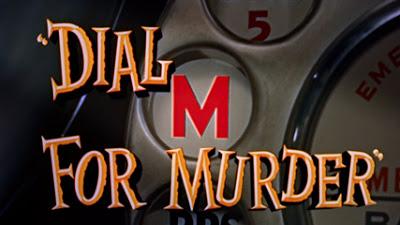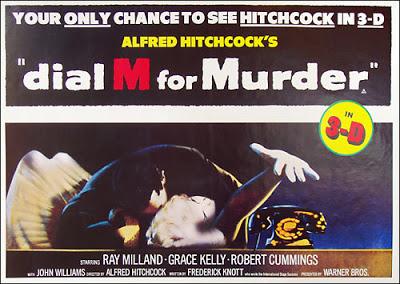
My introduction to 3D movies finally came this past weekend and I’m sure it surprises no one who knows me that this happened by way of a classic rather than one of today’s CGI extravaganzas. My initiation into stereoscopic 3D film, a process that has been around forever but has gained a firm foothold only recently, took place on Sunday afternoon, when I happily watched the only 3D film Alfred Hitchcock ever made with a near-full-house audience at one of my favorite theaters, the Rafael.
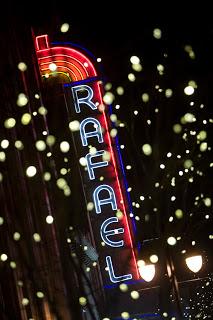
The Rafael Theatre, San Rafael, CA
Dial M for Murder (1954) was the last film Hitchcock made as part of his deal with Warner Bros., a studio that had a huge hit with the 3D horror thriller House of Wax in 1953. On the heels of that film’s box office success, Jack Warner decreed, for the moment, that Warners would or should make all subsequent films in 3D. Hitchcock, who was ever interested in evolving filmmaking technology, agreed to make his final film for the studio using 3D. It would be his first and last foray into the process. Because it could not be released until the Broadway play it was adapted from had ended its stage run, Dial M did not come out until mid-1954, just as public fascination with 3D films had begun to wane. In fact, once it went into wide release, the film screened far more often in 2D than 3D. The first “golden age” of 3D film had lasted only from 1952 until 1954; the process was an expensive and unwieldy undertaking at the time, and other, less difficult to produce and exhibit technologies, like CinemaScope, would move to the forefront.According to AMPAS, “Hitchcock used the All-Media rig developed by the optical department at Warner Bros. to experiment with stereoscopic techniques…” To emphasize the impact of 3D, he paid great attention to the film’s art direction, in particular, set design and decoration, as well as the placement of actors within each scene. Since the action, based as it was on a play, takes place primarily on one set, a London apartment interior, this sort of approach was a necessity. Of course, in the hands of an artist of Hitchcock’s caliber, 3D became a showcase not only for the drama at hand but, simultaneously, showcased the process itself. Hitchcock’s distinctive style coupled with the potency of 3D makes for an intense and evocative film experience. All that transpires onscreen - from a woman quietly reading her newspaper to a violent scene of attempted murder - is enhanced by the director's grasp of the 3D format.
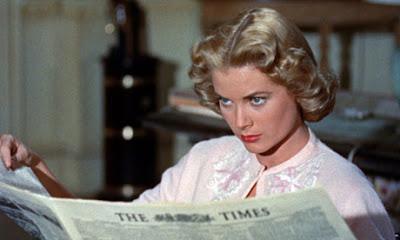
Grace Kelly
I have seen Dial M for Murder many times in 2D. I think it may have been the first Hitchcock film I ever saw. There was once a local Los Angeles TV station that aired a different movie every week, all week: in the early evening five nights, Monday through Friday, and then again Saturday night. Was it KTLA? One week the movie was Dial M. And I watched it every night. Hooked by Hitchcock at a young age! But Dial M hasn’t been a favorite of mine. After seeing Vertigo, Rear Window, Notorious, Strangers on a Train, Shadow of a Doubt, Psycho, ETC., it seemed fairly tepid fare. And yet, when I found out it was to be screened at the Rafael, I instantly purchased tickets online. I had realized by now that Hitchcock on the big screen is a different experience from Hitchcock on the small screen (even on a good-sized small screen in HD). This realization first dawned on me when I attended a screening of the silent version of Blackmail (1929) at the Rafael a few years ago and grew more profound with later viewings of North by Northwest (1959), also at the Rafael, and Vertigo (1958), at the Paramount, Oakland’s Art Deco movie palace.
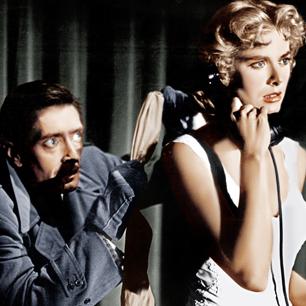
Anthony Dawson and Grace Kelly
I was not disappointed with the newly restored Dial M for Murder in Dolby 3D. At all. With visual depth and dimension it seemed to me a different film. Where, before, the film had seemed as flat as its two-dimensional format, it now, literally, came to life. I’d thought of it as talky and static (as filmed plays often are) but now its atmosphere teemed with suspense, every word spoken implied more, facial expressions and physical movements suggested barely concealed undercurrents. Dialogue-heavy as it is, the film now seemed to move along at a brisk clip. Though one scene was obviously designed for 3D (and must’ve caused quite a stir when the film was first shown), Hitchcock clearly understood 3D and exploited it with precision in every frame.
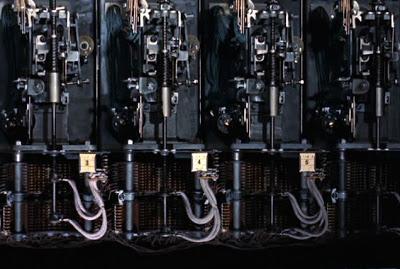
dialing M...
Among Dial M for Murder’s claims to fame is that it was the first of Hitchcock’s three films starring Grace Kelly. He had first seen the young actress opposite Robert Alda in an early ‘50s screen test for Taxi, a film that was never made. She would go on to make High Noon (1952) with Gary Cooper for Fred Zinnemann and Mogambo (1953) with Clark Gable and Ava Gardner for John Ford before Hitchcock managed to cast her in Dial M. If director Gregory Ratoff thought Kelly was perfect for the role of the Irish lass she might have played in Taxi because, he said, “she’s not pretty,” Hitchcock saw something else entirely. By the time the two were finished making pictures together in 1955, Kelly was vaunted as one of the most beautiful women in Hollywood - due in no small part to Hitchcock’s presentation of her.
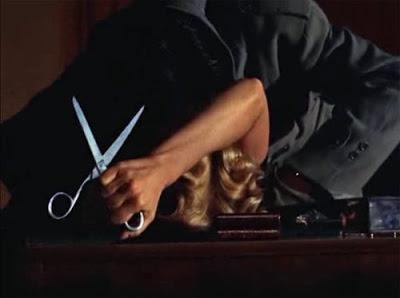
A scene designed for 3D
Thanks to the resurgence of 3D, Dial M for Murder can now be seen as it was originally conceived and appreciated as the bona fide classic it is.
